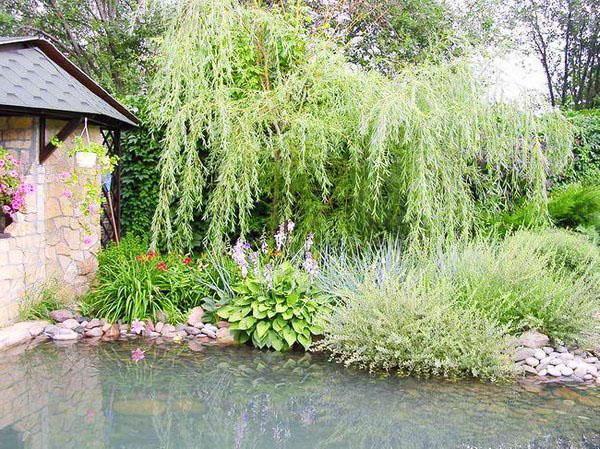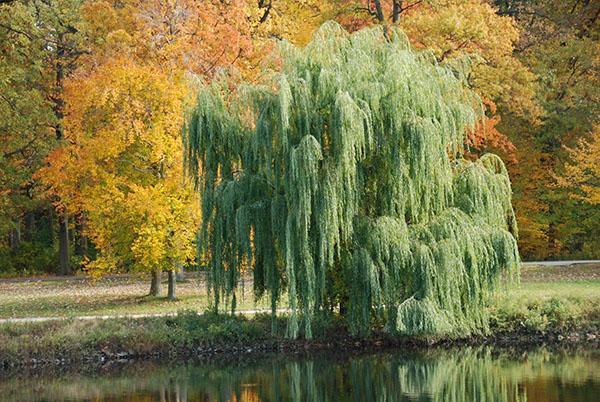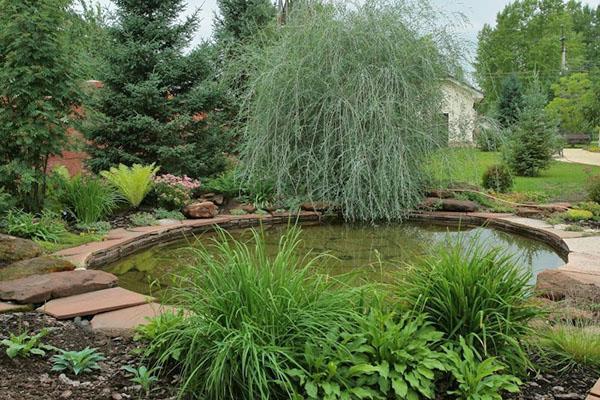Original landscaping of the site using weeping trees
 To decorate and diversify their garden, summer residents plant original varieties of fruit trees, install fountains and statues, and also plant colorful flower beds. Weeping trees, which, like green fountains, will set off flower plantings will be an excellent addition.
To decorate and diversify their garden, summer residents plant original varieties of fruit trees, install fountains and statues, and also plant colorful flower beds. Weeping trees, which, like green fountains, will set off flower plantings will be an excellent addition.
Weeping trees in the country

If there is no pond on the site, then you can create an illusion of it. To do this, plant a weeping tree, and fill the space around for several meters with moss. Plant marsh iris or reeds at the border, separating the illusory reservoir from the rest of the territory.
 It is best to install a group of weeping trees of various heights in the center of the site. Under their spreading crowns, you can walk, fleeing the heat, or put benches and a table, making a seating area.
It is best to install a group of weeping trees of various heights in the center of the site. Under their spreading crowns, you can walk, fleeing the heat, or put benches and a table, making a seating area.
If you have a playground at your dacha, then weeping trees will add extra privacy and comfort to it.
 For a large garden with fruit trees, you can use low-growing varieties of weeping fruit crops, for example, weeping mountain ash or apple tree... The rowan will look stylish and bright for many years to come.
For a large garden with fruit trees, you can use low-growing varieties of weeping fruit crops, for example, weeping mountain ash or apple tree... The rowan will look stylish and bright for many years to come.
 In spring, it will bloom with numerous white inflorescences, which will be replaced by bright fruits in summer. The tree will keep the berries throughout the winter, and the yellow-red leaves will look spectacular in contrast to the snow.
In spring, it will bloom with numerous white inflorescences, which will be replaced by bright fruits in summer. The tree will keep the berries throughout the winter, and the yellow-red leaves will look spectacular in contrast to the snow.

Some weeping trees will not be suitable for a small garden due to their large size. For such areas, special varieties of small sizes have been developed.
Choosing a weeping tree
 When choosing a variety, one should proceed from several criteria:
When choosing a variety, one should proceed from several criteria:
- site layout and design;
- soil features;
- the presence of light;
- flowering period.
 Some trees love wetter soil and light, and bloom in summer, others grow well in the shade and reach their peak only in autumn. The variety of varieties gives you the opportunity to choose a tree that is suitable specifically for your site.
Some trees love wetter soil and light, and bloom in summer, others grow well in the shade and reach their peak only in autumn. The variety of varieties gives you the opportunity to choose a tree that is suitable specifically for your site.
Weeping willow
 Ideal for alleys and hedges. The tree grows to a height of 15 m and is characterized by large flowing branches. It blooms with beautiful long "earrings". The preferred soil for planting is loam, however, weeping willow grows successfully on other soil. For the winter, the tree should be well covered, frost resistance is not included in the list of its advantages. Otherwise, willow is easy to care for.
Ideal for alleys and hedges. The tree grows to a height of 15 m and is characterized by large flowing branches. It blooms with beautiful long "earrings". The preferred soil for planting is loam, however, weeping willow grows successfully on other soil. For the winter, the tree should be well covered, frost resistance is not included in the list of its advantages. Otherwise, willow is easy to care for.
Provide abundant watering immediately after planting.
Weeping birch
 This variety is sometimes called "drooping" or "warty" birch. A beautiful slender tree reaches a height of 20 m. It is characterized by fast growth and good winter hardiness. Weeping birch loves light and space, and also grows well in any soil.
This variety is sometimes called "drooping" or "warty" birch. A beautiful slender tree reaches a height of 20 m. It is characterized by fast growth and good winter hardiness. Weeping birch loves light and space, and also grows well in any soil.
Weeping ash
 This short tree is best planted pointwise in open spaces. Ash trees require a lot of light and calcium-rich soil to grow. The tallest specimens, as a rule, do not exceed 8 meters in height.
This short tree is best planted pointwise in open spaces. Ash trees require a lot of light and calcium-rich soil to grow. The tallest specimens, as a rule, do not exceed 8 meters in height.
Weeping pine
 The pine tree is planted for the sake of the famous dense crown. It is beautiful in winter and summer, falling almost like a solid wall. Among the most popular varieties of weeping pine, black, yellow and Weymouth should be distinguished. They all need a lot of light and are picky about the composition of the soil.
The pine tree is planted for the sake of the famous dense crown. It is beautiful in winter and summer, falling almost like a solid wall. Among the most popular varieties of weeping pine, black, yellow and Weymouth should be distinguished. They all need a lot of light and are picky about the composition of the soil.
Weeping acacia
 This tree is distinguished by its immense endurance. It tolerates cold and drought, does not require light and grows on any soil. Suitable for small areas up to 2 meters in size. During the flowering period, acacia pleases with beautiful yellow inflorescences, and in the summer its leaves turn bright green.
This tree is distinguished by its immense endurance. It tolerates cold and drought, does not require light and grows on any soil. Suitable for small areas up to 2 meters in size. During the flowering period, acacia pleases with beautiful yellow inflorescences, and in the summer its leaves turn bright green. https://www.youtube.com/watch?v=NdX9KkbRf4g
https://www.youtube.com/watch?v=NdX9KkbRf4g
Weeping larch
 Larch looks great in planting in groups of several. These trees are best suited for large plots, they grow up to 10 m with a crown span of 3 m. Grow in fertile soil with good drainage. Weeping larch is a light-loving plant, so do not plant it in the shade of house walls or other trees.
Larch looks great in planting in groups of several. These trees are best suited for large plots, they grow up to 10 m with a crown span of 3 m. Grow in fertile soil with good drainage. Weeping larch is a light-loving plant, so do not plant it in the shade of house walls or other trees.
Examples of the location of weeping trees
 To make weeping trees look appropriate and fit into the landscape, they should be placed next to those objects and structures with which the shape of the tree will be in harmony. For example, if you have a fountain that beats vertically, and the jets are directed downward in an arc, it will be very effective to plant a weeping tree, with the shape of branches repeating the movement of water. This way you can admire 2 "fountains" at once on different scales.
To make weeping trees look appropriate and fit into the landscape, they should be placed next to those objects and structures with which the shape of the tree will be in harmony. For example, if you have a fountain that beats vertically, and the jets are directed downward in an arc, it will be very effective to plant a weeping tree, with the shape of branches repeating the movement of water. This way you can admire 2 "fountains" at once on different scales.
If you want to create a shady spot for a relaxing break, it is best to plant some weeping willows. Their thick trunks and spreading crowns will reliably shelter from rain and sun.
 Thanks to the plastic branches, weeping varieties can be used to make bizarre architectural forms, arches and natural awnings.
Thanks to the plastic branches, weeping varieties can be used to make bizarre architectural forms, arches and natural awnings.